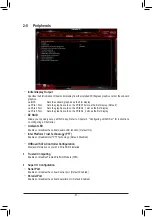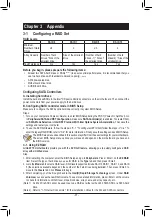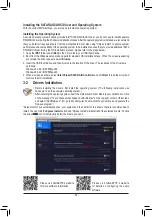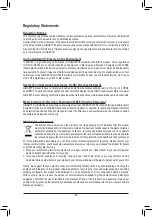
C-2. UEFI RAID Configuration
Only Windows 10/8.1 64-bit supports UEFI RAID configuration.
Step:
1. In BIOS Setup, go to
BIOS
and set
Windows 8/10 Features
to
Windows 8/10
and
CSM Support
to
Disabled
.
Save the changes and exit BIOS Setup.
2. After the system reboot, enter BIOS Setup again. Then enter the
Peripherals\Intel(R) Rapid Storage
Technology
sub-menu.
3. On the
Intel(R) Rapid Storage Technology
menu, press <Enter> on
Create RAID Volume
to enter the
Create RAID Volume
screen. Enter a volume name with 1~16 letters (letters cannot be special characters)
under the
Name
item and press <Enter>. Then, select a RAID level. RAID levels supported include RAID
0, RAID 1, RAID 10, and RAID 5 (the selections available depend on the number of the hard drives being
installed). Next, use the down arrow key to move to
Select Disks
.
4. Under
Select Disks
item, select the hard drives to be included in the RAID array. Press the <Space> key
on the hard drives to be selected (selected hard drives are marked with "X"). Then set the stripe block size.
The stripe block size can be set from 4 KB to 128 KB. Once you have selected the stripe block size, set the
volume capacity.
5. After setting the capacity, move to
Create Volume
and press <Enter> to begin.
6. After completing, you'll be brought back to the
Intel(R) Rapid Storage Technology
screen. Under
RAID
Volumes
you can see the new RAID volume. To see more detailed information, press <Enter> on the volume
to check for information on RAID level, stripe block size, array name, and array capacity, etc.
C-3. Configuring Legacy RAID ROM
Enter the Intel
®
legacy RAID BIOS setup utility to configure a RAID array. Skip this step and proceed with the
installation of Windows operating system for a non-RAID configuration.
Step:
1. In BIOS Setup, go to
BIOS
and set
CSM Support
to
Enabled
and
Storage Boot Option Control
to
Legacy
.
Save the changes and exit BIOS Setup. After the POST memory test begins and before the operating system
boot begins, look for a message which says "Press <Ctrl-I> to enter Configuration Utility". Press <Ctrl> + <I>
to enter the RAID Configuration Utility.
2. After you press <Ctrl> + <I>, the
MAIN MENU
screen will appear. If you want to create a RAID array, select
Create RAID Volume
in
MAIN MENU
and press <Enter>.
3. After entering the
CREATE VOLUME MENU
screen, enter a volume name with 1~16 letters (letters cannot
be special characters) under the
Name
item and press <Enter>. Then, select a RAID level. RAID levels
supported include RAID 0, RAID 1, RAID 10, and RAID 5 (the selections available depend on the number of
the hard drives being installed). Press <Enter> to proceed.
4. Under
Disks
item, select the hard drives to be included in the RAID array. If only two hard drives are installed,
they will be automatically assigned to the array. Set the stripe block size if necessary. The stripe block size
can be set from 4 KB to 128 KB. Once you have selected the stripe block size, press <Enter>.
5. Enter the array capacity and press <Enter>. Finally press <Enter> on the
Create Volume
item to begin
creating the RAID array. When prompted to confirm whether to create this volume, press <Y> to confirm or
<N> to cancel.
6.
When completed, you can see detailed information about the RAID array in the
DISK/VOLUME INFORMATION
section, including the RAID level, stripe block size, array name, and array capacity, etc. To exit the RAID
BIOS utility, press <Esc> or select
6. Exit
in
MAIN MENU
.
Please visit GIGABYTE's website for details on configuring a RAID array.
- 38 -
Summary of Contents for GA-H270-HD3
Page 42: ... 42 ...
Page 43: ... 43 ...




































